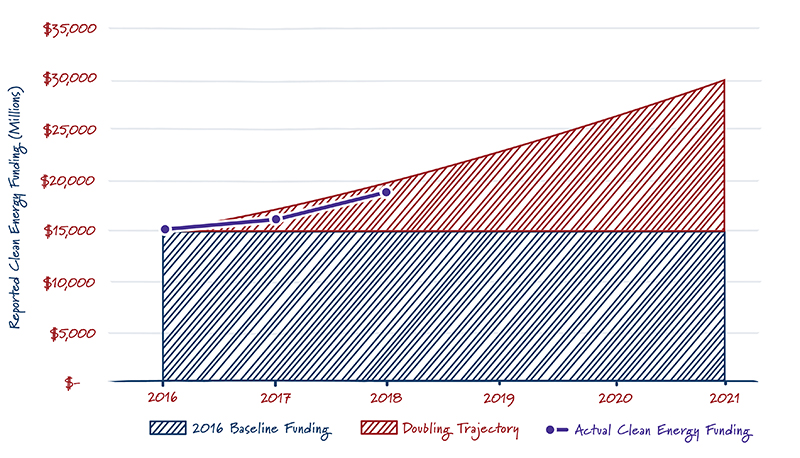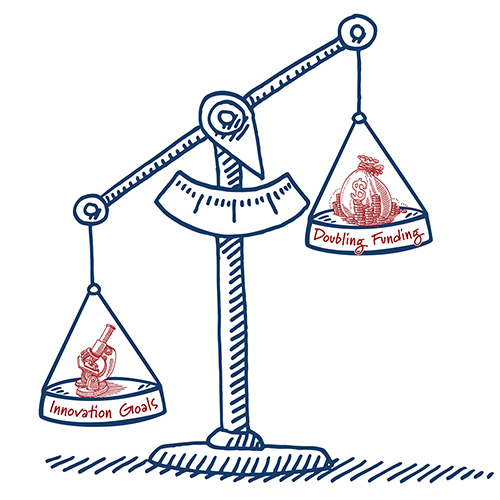Mission Innovation (MI) is an initiative by 22 countries and the European Commission to increase collaboration on clean energy research and development (R&D). The initiative was launched in 2015 by the United States, France, India and a coalition of business leaders led by Bill Gates known as the “Breakthrough Energy Coalition.” The initial focus was to “double clean energy R&D funding within 5 years.” Baseline committed funding in 2016 was $14.8 Billion USD, with a collective goal of $30 Billion USD by 2021.1

MI’s activities are organized by a Secretariat that is currently based in the UK (though much of the original organizing work was conducted from the U.S. Department of Energy, with an inaugural 2016 meeting held in San Francisco). The Secretariat coordinates with member countries to organize the annual Mission Innovation Ministerial (MIM), as well as helping organize the activities of the Innovation Challenges. The 3rd annual MIM was held the week of May 22 in Malmö, Sweden and attended by U.S. Deputy Secretary of Energy Dan Brouillette and other high-level DOE officials. The MIM serves as a high-level gathering for government representatives to report on energy R&D progress and successes.
MI has no legally binding component2 and is instead intended to be a voluntary cooperation program to advance R&D and reduce the cost of clean energy technologies. The U.S. clean energy R&D baseline in FY16 was $6.4 billion and conducted or supported by 12 federal agencies. DOE represented 75% of that baseline amount.3 At the time of the launch, the U.S. committed to increasing its investments from $6.4 billion to $12.8 billion. Under the current Administration and Congress, direct clean energy R&D funding at the DOE has increased by over $600 million since the baseline was set in FY16, the second largest increase in R&D after China.4
While overall global clean energy funding since the start of MI has grown by approximately 22% and has so far been on track to meet the final target,5 it’s important to note that this can be a bit misleading. In some countries the spending initially reported in the baseline was significantly lower than actual energy R&D spending, allowing a certain amount of gaming of the system.6

Each of these “Innovation Challenges” has one or more countries leading on coordinating activities. Each Innovation Challenge has begun organizing workshops and technology development roadmaps, which are intended to eventually lead to more successful R&D outcomes.
While the current Administration has been assessing its position in MI, it has been much more engaged in the sister effort called the Clean Energy Ministerial (CEM), an international clean energy deployment initiative that has been operating for 8 years. Unlike MI’s research focus, the activities of the CEM have largely included coordination of data and best practices for the deployment of various clean energy technology areas, historically with a focus on intermittent technologies such as solar and wind energy. Energy Secretary Rick Perry has recently pushed for reforms within CEM to also support nuclear and clean fossil energy technologies. At the CEM meeting in May, the U.S. launched new initiatives on nuclear energy and carbon capture to ensure that these technologies are justly recognized for their global clean energy benefits. The U.S. is a leader in the development of both nuclear and carbon capture and inclusion of these technologies in CEM will result in new business opportunities for American companies. There has already been significant attention on these new initiatives, with 15 of 25 CEM members nations expressing interest in participating in the nuclear effort alone.8



Another option to consider is international collaboration on low-emission or zero-emission industrial sector processes. The industrial sector is expected to grow at the same rate as the power sector globally over the next 20 years and is likely to contribute a much larger share of total emissions.9 There are interesting pilot projects taking place in Sweden10 and the UAE11, but many interesting technologies remain in the lab.12
3. Ensure Accountability and Transparency: Data collection and management under the MI framework must be improved to accurately track progress and improve accountability. For example, the definitions of clean energy research, development and demonstration (RD&D) should be harmonized across the participating entities to the greatest extent possible. Some countries exclude certain types of investments, while others do not specify the categories of investment. For example, some countries include demonstration costs in their “R&D accounting,” while others do not. In order to support changing MI to an outcomes-based approach, additional reporting metrics from each country will likely be required. Some example metrics could include cost reductions by technology, rates of improvement in individual technologies and patents granted in clean energy R&D. While the “action plan” presented at the third MI Ministerial mentions additional strengthening of R&D reporting, it makes no mention of what metrics or granularity will ultimately be provided.13
